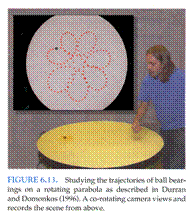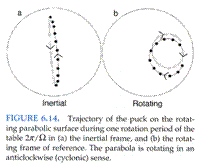
ESS227
Prof. Jin-Yi Yu
•An air or water mass moving with speed V subject only to the Coriolis force travels in a circular trajectory called an 'inertial circle'.
•Since the force is directed at right angles to the motion of the particle, it will move with a constant speed, and perform a complete circle with frequency f.
•The magnitude of the Coriolis force also determines the radius of this circle: Radius = V/f.
•On the Earth, a typical mid-latitude value for f is 10−4 s−1; hence for a typical atmospheric speed of 10 m/s the radius is 100 km, with a period of about 14 hours.
•In the ocean, where a typical speed is closer to 10 cm/s, the radius of an inertial circle is
1 km.
•These inertial circles are clockwise in the northern hemisphere (where trajectories are bent to the right) and anti-clockwise in the southern hemisphere.


Inertial Cycle